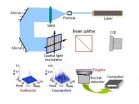(Press-News.org) GAINESVILLE, Fla. --- University of Florida researchers have found evidence that an influenza A virus can jump from horses to camels – and humans could be next.
The One Health Center of Excellence for Research and Training in UF's Emerging Pathogens Institute, in collaboration with U.S. and Mongolian institutions, has identified the first known case of an equine influenza virus in camels. Their findings will be published in the December issue of Emerging Infectious Diseases, but an ahead of print version of the report is available here:
http://wwwnc.cdc.gov/eid/article/20/12/14-0435_article
"Over the last 10 years, we've been amazed at all the cross-species jumps of influenza. Now we're finding yet another," said Gregory C. Gray, center director and environmental and global health professor in UF's College of Public Health and Health Professions.
Although there is no immediate risk, the inter-mammalian transmission of the virus is a major concern for public health researchers interested in controlling the threat of pandemic influenza, he said.
Camels have recently been implicated in the transfer of the deadly Middle East respiratory syndrome virus to man. This new discovery further demonstrates the potential role of camels in the ecology of zoonotic diseases, which are passed from animals to humans. Other examples include SARS virus, Ebola virus, and some harmful strains of E. coli.
"Similar influenza viruses can move from horses to humans," Gray said. "If a camel has it, why couldn't they share it with humans?"
The study took place in 2012 in three Mongolian aimags, or provinces, where free-range camels and horses intermingle.
Hundreds of camel and horse nasal samples were collected, and one camel specimen was confirmed to have influenza A. Tests found it matched viruses in Mongolian horses.
This also illustrates the importance of improved surveillance for zoonotic diseases in camels to better understand the potential risk to humans, he said.
"It adds another potential exposure to man where a novel virus could hide out, if you will, in camels and later surprise us and infect humans," Gray said.
This could affect animal caretakers, especially in places where people have close contact with camels such as the Middle East, Africa, and Australia.
More research is necessary to fully understand the virus – for example, how it's transmitted – but Gray said the discovery "adds another dimension to what we do."
"Knowing that influenza virus can jump between horses and camels will reshape how we understand the ecology of novel influenza viruses which may affect man," he said.
INFORMATION:
The project was funded by the U.S. National Institutes of Health and involved the Institute of Veterinary Medicine in Mongolia as well as the J. Craig Venter Institute and St. Jude Children's Research Hospital.
UF part of research team that finds equine influenza virus in camels
2014-06-24
ELSE PRESS RELEASES FROM THIS DATE:
Prior drug use is the greatest predictor of ecstasy use US high school seniors
2014-06-24
Ecstasy, also known by its chemical abbreviation MDMA, is an illicit drug that is commonly taken at nightclubs and dance parties. Ecstasy's street names include: "Molly" (U.S.), "Mandy" (U.K.), "E," and "X." Although not limited to nightlife scenes, ecstasy is popular at dance parties, as it tends to enhance the party experience (e.g., perceptions of lights and music, nightlife socialization).
A study just published in the journal Substance Use & Misuse by researchers affiliated with New York University's Center for Drug Use and HIV Research (CDUHR), examined a national ...
New study uses blizzard to measure wind turbine airflow
2014-06-24
A first-of-its-kind study by researchers at the University of Minnesota (UMN) using snow during a Minnesota blizzard is giving researchers new insight into the airflow around large wind turbines. This research is essential to improving wind energy efficiency, especially in wind farms where airflows from many large wind turbines interact with each other.
The study by researchers at the UMN College of Science and Engineering's St. Anthony Falls Lab was published today in Nature Communications, a major scientific journal.
Wind energy is one of the fastest-growing renewable ...
Consumers looking for reduced sugar and salt in food products more than low- and no-fat
2014-06-24
More than 50 percent of consumers are interested in products with reduced levels of salt and sugar, and yet new products in the United States are more likely to tout low- or no-fat attributes, according to a June 23 panel discussion at the 2014 Institute of Food Technologists (IFT) Annual Meeting & Food Expo® in New Orleans.
In recent research, just 25 percent of consumers claimed to be dieting, yet more than 70 percent said they want to lose weight.
"Consumers know they need to take care of their health," said Lynn Dornblaser, director, innovation & insight, Mintel ...
From deep sea to deep space
2014-06-24
How do you feed a six-person crew on a three-year mission to Mars?
Food scientists are working on this and other challenges related to creating and optimizing food for astronauts, soldiers, pilots and other individuals working and living in extreme environments, according to a June 23 panel discussion at the 2014 Institute of Food Technologists (IFT) Annual Meeting & Food Expo® in New Orleans.
The constraints often are similar whether the food is created for the desert, mountains, deep sea or space – it needs to be nutritious, palatable, light-weight, easy to store ...
Energy drinks raise new questions about caffeine's safety
2014-06-24
Caffeine, which was extensively researched for possible links to birth defects in animals and cardiovascular disease in humans over 30 years ago and then exonerated, has become the focus of renewed concerns as caffeine-containing energy drinks have surged in popularity. However, according to a June 23rd panel discussion at the 2014 Institute of Food Technologists (IFT) Annual Meeting & Food Expo® in New Orleans, a rich database of health evidence exists confirming the safety of caffeine for consumers at current levels of exposure. What isn't known, however, is how caffeine ...
Ghost writing the whip
2014-06-24
WASHINGTON D.C., June 24, 2014 – "Ghost imaging" sounds like the spooky stuff of frivolous fiction, but it's an established technique for reconstructing hi-res images of objects partly obscured by clouds or smoke. Now a group of researchers at the National University of Singapore (NUS) is applying the same idea in reverse to securing stored or shared electronic data.
Described in the journal Applied Physics Letters, from AIP Publishing, the work establishes "marked ghost imaging" technology as a new type of multi-layer verification protocol for data storage or transmission.
By ...
Researchers mapping your route from illness to illness
2014-06-24
This is the first time that researchers have analysed big data relating to an entire country's disease development. The new ground-breaking results are based on data from 6.2 million Danes who were followed for 14.9 years – using state-of-the-art systems biology, researchers have boiled down the massive amount of data to 1,171 so-called thoroughfares with central information on the course of diabetes, chronic obstructive pulmonary disease, cancer, arthritis and cardiovascular disease. The researchers are, in other words, able to forecast whether you are driving on a risky ...
New technology: The goose bump sensor
2014-06-24
WASHINGTON D.C., June 24, 2014 – Can emotional states be measured quantitatively, and if so what would advertising, manufacturing and social media companies do with that data? Imagine a world in which a consumer's real-time physical and emotional response helped to determine his/her experience of music, online ads or the temperature in the room.
That may not be so far away -- a team of researchers at KAIST in Daejeon, South Korea has developed a flexible, wearable 20mm x 20mm polymer sensor that can directly measure the degree and occurrence on the skin of goose bumps ...
Roux-en-Y gastric bypass surgery may reduce heart disease risk
2014-06-24
CHICAGO, IL—Obese patients with Type 2 diabetes who don't have excessive surgical risk may find that Roux-en-Y gastric bypass (RYGB) surgery can help them reduce their risk of heart disease, a new clinical trial shows. The results were presented Tuesday at ICE/ENDO 2014, the joint meeting of the International Society of Endocrinology and the Endocrine Society in Chicago.
"There is emerging evidence highlighting the potential health benefits of bariatric surgery in managing obese patients with Type 2 diabetes. In the past, lifestyle advice and medications provided the ...
Sleep, mood improves after substantial weight loss
2014-06-24
CHICAGO, IL—Obese adults who lose at least 5 percent of their body weight report that they sleep better and longer after six months of weight loss, according to a new study. The results were presented Tuesday at the joint meeting of the International Society of Endocrinology and the Endocrine Society: ICE/ENDO 2014 in Chicago.
"This study confirms several studies reporting that weight loss is associated with increased sleep duration," said the study's lead investigator, Nasreen Alfaris, MD, MPH, a fellow in the Department of Medicine at the Perelman School of Medicine ...

